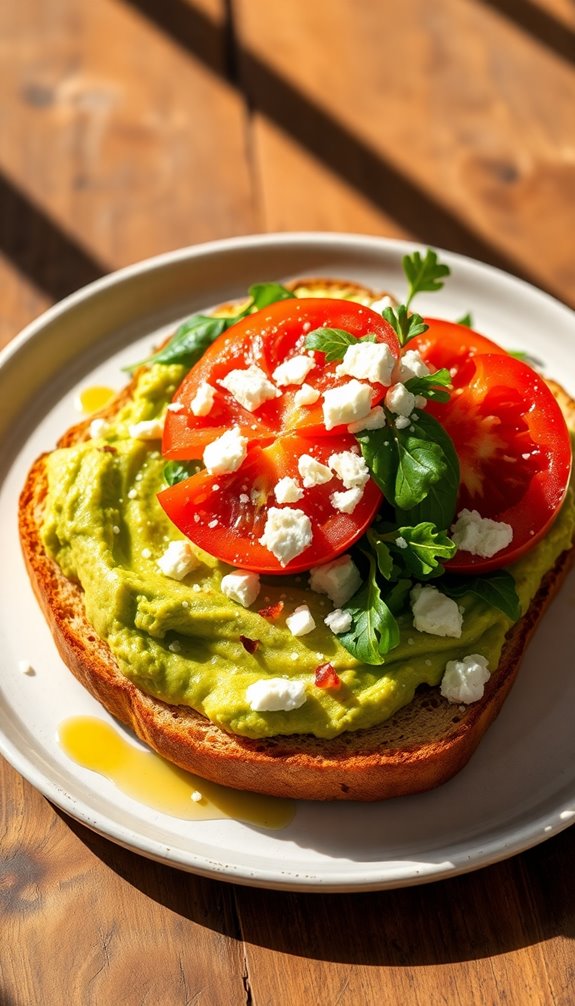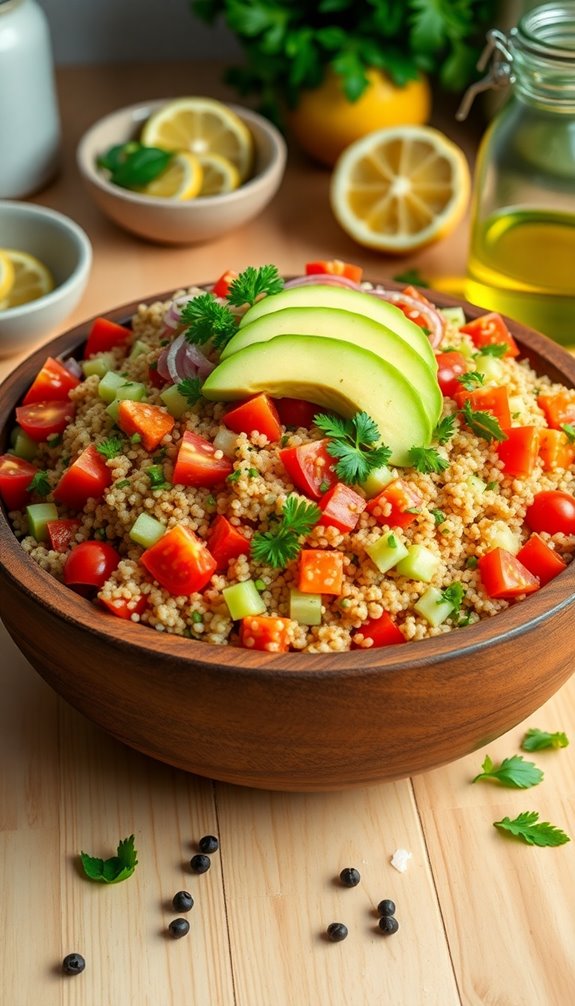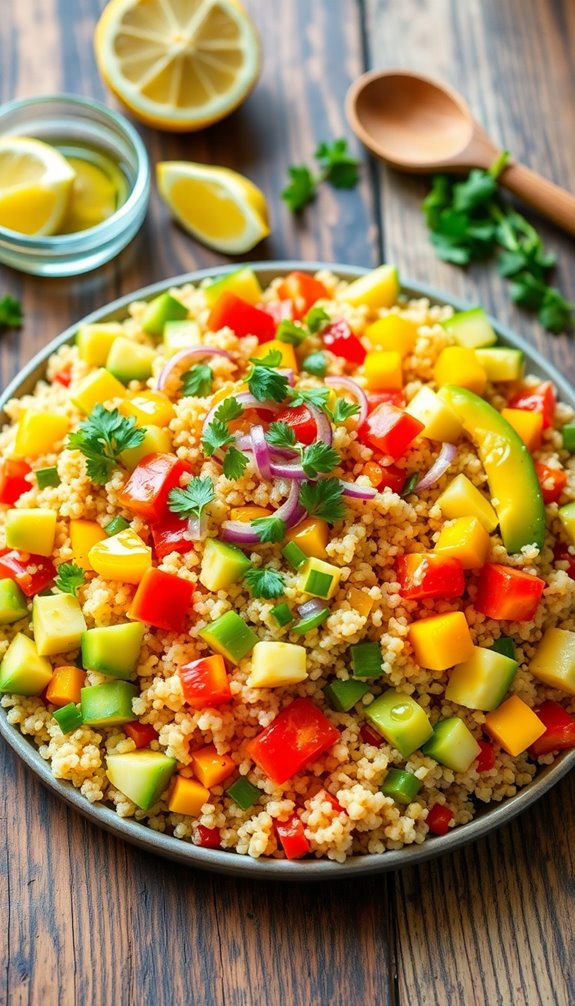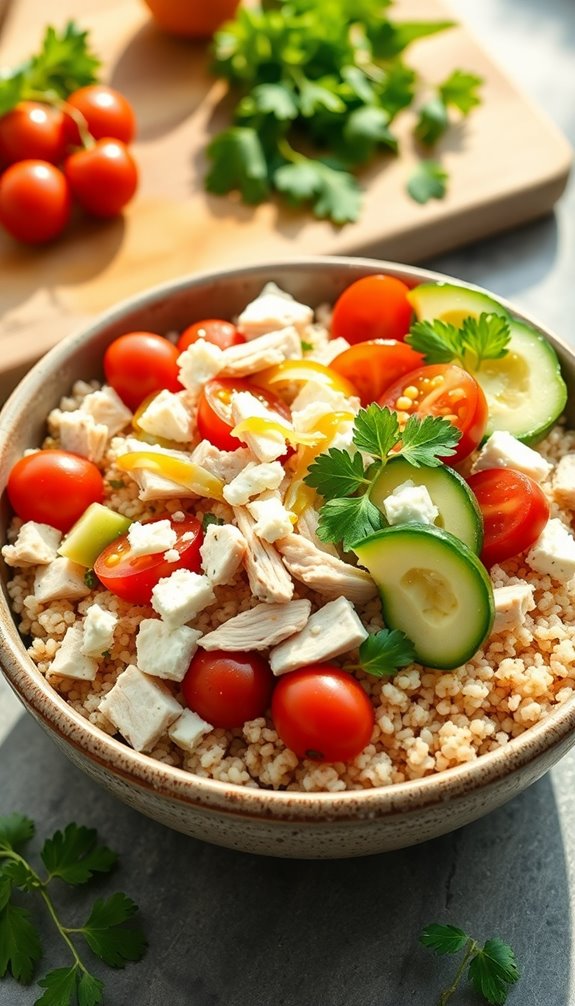When it comes to managing diabetes, choosing the right lunch can greatly impact your energy levels and overall health. A balanced meal not only keeps you satisfied but also helps stabilize blood sugar. One option that's both nutritious and flavorful is a quinoa salad loaded with fresh vegetables. This recipe offers a delightful mix of textures and colors, making it a perfect midday choice. Curious about how to prepare this satisfying dish? Let's explore the cooking process.
Recipe Tips and Tricks
- Use quinoa as a base for salads to increase fiber and protein while managing blood sugar levels.
- Incorporate non-starchy vegetables like bell peppers and cucumbers for added nutrients and lower carbohydrate content.
- Choose healthy fats, such as olive oil, to enhance flavor without spiking blood sugar.
- Add lean proteins, like grilled chicken or chickpeas, to promote satiety and maintain stable blood sugar levels.
- Limit added sugars and unhealthy fats while focusing on whole, unprocessed foods for balanced meals.
How To Make It – Recipe

Creating a diabetic-friendly lunch doesn't have to be complicated or lack flavor. In this recipe, we'll prepare a delicious quinoa salad that combines healthy ingredients to provide a balanced meal. Quinoa serves as an excellent base due to its high protein content and low glycemic index, making it a perfect choice for those monitoring their blood sugar levels. Additionally, quinoa is considered a high protein low calorie option, ideal for maintaining a healthy diet.
We'll complement it with vibrant vegetables and a zesty dressing to guarantee every bite is satisfying and nutritious. This quinoa salad isn't only easy to prepare but also versatile. You can customize it with your favorite vegetables or proteins, making it a go-to recipe for any day of the week.
It's light yet filling, and it can be made in advance, making it a great option for meal prep. Let's plunge into the ingredients and get started on this delightful dish.
Ingredients:
- 1 cup quinoa
- 2 cups water or low-sodium vegetable broth
- 1 cup cherry tomatoes, halved
- 1 cucumber, diced
- 1 bell pepper (any color), diced
- 1/4 red onion, finely chopped
- 1/4 cup fresh parsley, chopped
- 1/4 cup feta cheese (optional)
- 2 tablespoons olive oil
- 1 tablespoon lemon juice
- Salt and pepper to taste
Cooking Instructions:
Begin by rinsing the quinoa under cold water to remove any bitterness. In a medium saucepan, combine the quinoa and water or vegetable broth, then bring to a boil.
Once boiling, reduce the heat to low, cover, and let it simmer for about 15 minutes or until the quinoa is fluffy and the liquid is absorbed. While the quinoa is cooking, prepare the vegetables by chopping the cherry tomatoes, cucumber, bell pepper, and red onion.
In a large bowl, combine the cooked quinoa, chopped vegetables, parsley, and feta cheese if using. Drizzle with olive oil and lemon juice, and season with salt and pepper to taste. Toss everything together until well combined.
Extra Tips:
For added flavor, consider roasting the vegetables beforehand, which will enhance their sweetness and bring out more depth in the dish. Additionally, you can substitute the olive oil with a light vinaigrette if you prefer a tangier taste.
This salad can be stored in the refrigerator for up to three days, making it a convenient option for leftovers. Adjust the seasoning according to your preference, and feel free to add grilled chicken or chickpeas for an extra protein boost.
Cooking Steps
To create a delicious diabetic-friendly lunch, start by chopping fresh vegetables finely to enhance their flavors and textures.
Next, sauté these vegetables in olive oil, which is a heart-healthy fat, and consider adding a protein source for balance.
Finally, season your dish with herbs and spices, and finish with a splash of vinegar for a zesty kick. Including fiber-rich ingredients can also help stabilize blood sugar levels, making your meal even more diabetic-friendly.
Step 1. Chop Fresh Vegetables Finely
Chop fresh vegetables finely to enhance their flavor and texture in your diabetic-friendly lunch recipe.
Use effective chop techniques, like the claw grip for safety and uniformity. Choose vegetable varieties such as bell peppers, zucchini, and carrots to add color and nutrients.
Smaller pieces help release essential flavors and guarantee even cooking, making your meal both delicious and satisfying for your health needs.
Step 2. Sauté Vegetables in Olive Oil
Heat a skillet over medium heat and add a tablespoon of olive oil to get started on sautéing your vegetables.
Olive oil benefits include promoting heart health and providing essential antioxidants.
Use sautéing techniques like stirring frequently to guarantee even cooking and prevent burning. This method enhances flavors while retaining nutrients, making your lunch both delicious and diabetic-friendly.
Enjoy your vibrant, sautéed vegetables!
Step 3. Add Protein Source If Desired
Adding a protein source can enhance your sautéed vegetables, making your meal more satisfying and nutritious.
Consider chicken, tofu, or beans as protein options. These additions not only provide essential amino acids but also boost meal variety, helping you stay engaged with your diet.
Aim for balanced portions to maintain stable blood sugar levels while enjoying a delicious, diabetic-friendly lunch.
Step 4. Season With Herbs and Spices
Once you've chosen your protein and sautéed your vegetables, it's time to elevate the flavor profile of your dish by seasoning with herbs and spices.
Herbs like basil and oregano offer antioxidant benefits, while spice combinations such as cumin and paprika can enhance metabolism.
Experimenting with these ingredients not only adds flavor but also boosts the nutritional value of your diabetic-friendly lunch.
Step 5. Add a Splash of Vinegar
To enhance the tanginess and depth of your dish, consider adding a splash of vinegar during the cooking process.
Vinegar benefits your meal by balancing flavors and elevating overall taste. It acts as a flavor enhancement, helping to brighten and lift ingredients, especially in salads or marinades.
Just a small amount can make a significant difference, making your dish more enjoyable and satisfying.
Substitution Suggestions
While traditional recipes may call for ingredients that aren't suitable for a diabetic-friendly meal, you can easily make substitutions that maintain flavor and nutrition.
For example, replace white rice with quinoa for added fiber, or use Greek yogurt instead of sour cream for a protein boost. Additionally, swapping out traditional pasta for zucchini noodles can significantly reduce carbohydrate intake while still satisfying your cravings.
These ingredient alternatives offer substitution benefits that help manage blood sugar without sacrificing taste.
Serving Suggestions
How can you make your diabetic-friendly lunch more appealing?
Try incorporating healthy pairings like leafy greens with lean proteins for a nutrient boost.
Add flavor enhancements such as herbs, spices, or a squeeze of lemon to elevate taste without extra calories.
Serving your meal in colorful bowls or plates can also add visual appeal, making it more enjoyable and satisfying to eat. A perfect way to enhance your lunch is by including quick and delicious healthy lunch ideas that are both satisfying and nutritious.
Make-Ahead and Storage
Preparing your diabetic-friendly lunch in advance can save you time and help maintain your dietary goals throughout the week. Focus on meal prep by batch cooking and portioning out your meals. Use airtight containers for ideal food storage, which can keep your dishes fresh for up to four days. This approach not only simplifies your week but also encourages healthier eating habits. Additionally, consider incorporating effortless meal prep ideas that make cooking efficient and enjoyable.
Nutrition Facts(per serving)
Each serving typically contains around 300-400 calories, allowing you to manage your caloric content effectively. The macronutrient breakdown usually includes 15-20 grams of protein, 30-40 grams of carbohydrates, and healthy fats. Keeping track of these values helps you make informed choices while enjoying your meal. Incorporating healthy lunch ideas can also enhance your meal variety while ensuring you stay within your nutritional goals.
Final Thoughts
Maintaining a balanced diet is key to managing diabetes, and incorporating diabetic-friendly lunch options can make a significant difference.
By engaging in meal planning and making healthy swaps, you can enjoy flavorful meals without compromising your health. Including gluten-free options can also help diversify your meals while keeping them nutritious.
Remember, small changes can lead to big results, helping you maintain stable blood sugar levels while satisfying your taste buds.
Stay proactive and enjoy your meals!
Recipe FAQs
Can I Use Frozen Vegetables in This Recipe?
Absolutely, you can use frozen vegetables! They're packed with nutrients and can save time. Just remember, they might alter the meal's texture slightly, but the benefits far outweigh any minor changes. Enjoy your cooking adventure!
Is This Recipe Suitable for Vegetarians?
Yes, this recipe's suitable for vegetarians. You can easily use vegetarian substitutes for any non-vegetarian ingredients. Consider ingredient variations like tofu, legumes, or plant-based proteins to enhance flavor and nutrition while keeping it meat-free.
How Can I Adjust the Spice Level?
Did you know that around 70% of people prefer moderate spice levels? You can adjust spice alternatives like paprika or cumin to achieve a flavor balance that suits your taste while keeping the dish enjoyable.
What Kitchen Tools Do I Need?
To prepare effectively, you'll need essential kitchen tools like sharp knives, cutting boards, measuring cups, and mixing bowls. These tools enhance your cooking techniques, ensuring precision and efficiency in your culinary creations.
Can This Recipe Be Made in Advance for Meal Prep?
Yes, you can prep this meal in advance! For ideal freshness, store it in airtight containers. Meal prep not only saves time but guarantees you've healthy options ready. Follow these storage tips for best results.







